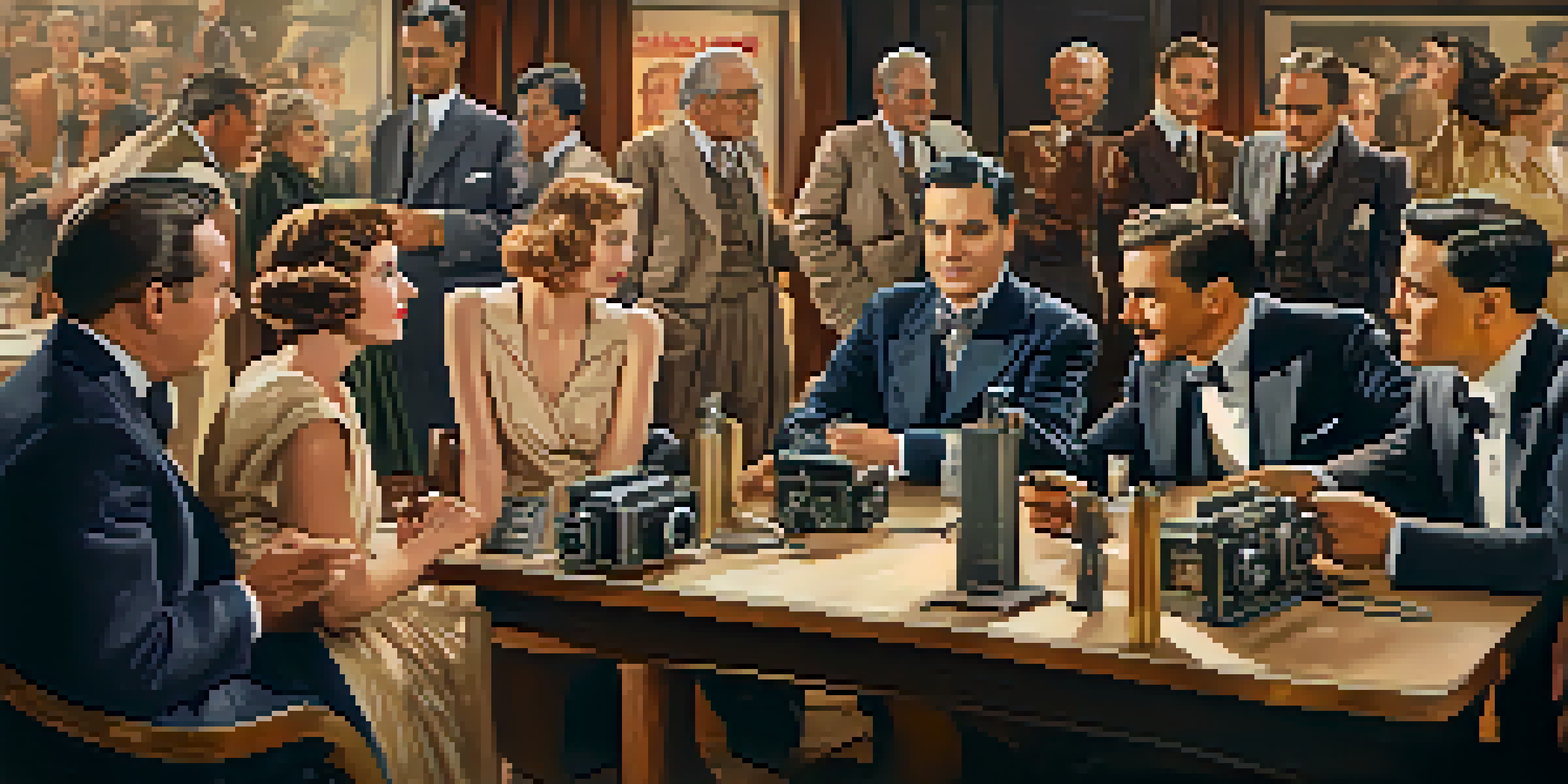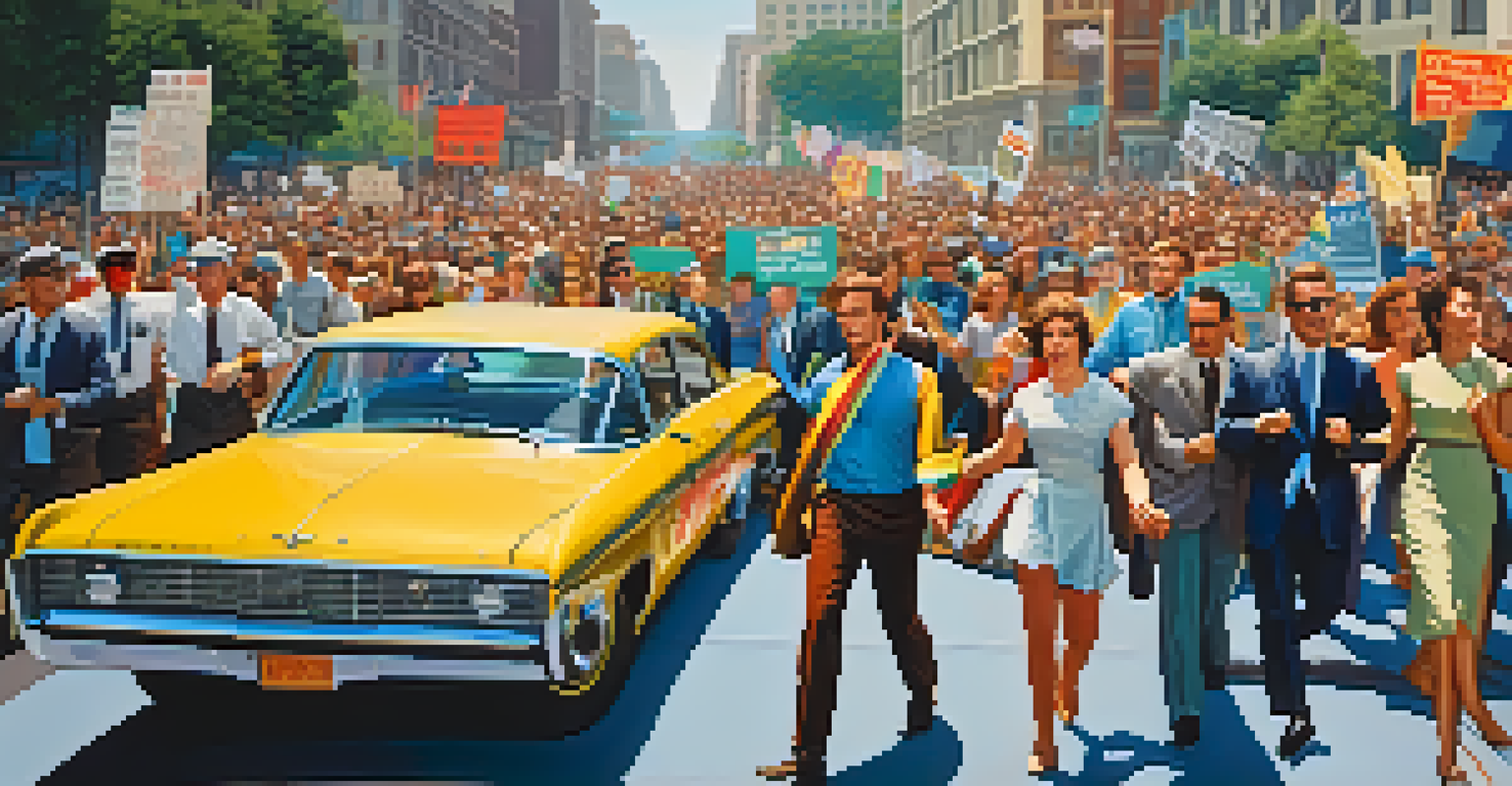The Evolution of Screen Actors Guild: Key Milestones

The Formation of the Screen Actors Guild in 1933
The Screen Actors Guild (SAG) was established in 1933, born out of a need for actors to unite for better working conditions. Prior to this, many performers faced exploitation, with long hours and low pay being the norm. The founding of SAG marked a turning point, as actors realized the power of collective bargaining. This early organization aimed to protect the rights of its members and ensure fair treatment in a rapidly growing industry.
The greatest weapon against stress is our ability to choose one thought over another.
SAG's formation was not just about unionizing; it represented a shift in how actors viewed their profession. For the first time, they could come together to advocate for better wages and working conditions. The initial push for the guild came from a handful of influential actors who recognized that solidarity would strengthen their position. This camaraderie laid the groundwork for more significant changes in Hollywood's treatment of performers.
By pooling their resources and voices, SAG quickly gained traction, attracting members from various backgrounds. The guild's early efforts were crucial in establishing a foundation for future negotiations and protections. As the industry evolved, so too would the guild, but the spirit of unity that began in 1933 would remain a core aspect of its identity.
The Fight for Fair Pay: The 1960s Strikes
The 1960s were a pivotal decade for SAG, marked by significant strikes that aimed to address fair pay for actors. As television became a dominant medium, actors were concerned about how their work was compensated in this new landscape. The guild organized strikes to demand residuals for television performances, which would ensure that actors received payments for reruns and syndication.

This period of activism highlighted the growing power of SAG, as actors rallied together to fight for their rights. The strikes not only brought attention to the pay disparity but also showcased the solidarity among performers. It became clear that when actors united, they could create substantial changes in the industry, setting a precedent for future negotiations.
Formation of SAG in 1933
The Screen Actors Guild was established to unite actors for better working conditions and fair treatment in the industry.
The successful outcome of these strikes in the late 1960s led to the establishment of residual payments, which fundamentally changed how actors were compensated. This victory solidified SAG's role as a powerful advocate for its members, ensuring that they would receive fair compensation for their work in both film and television. It was a landmark moment that shaped the future of the entertainment industry.
The Merger with the American Federation of Television and Radio Artists
In 2012, SAG underwent a significant transformation when it merged with the American Federation of Television and Radio Artists (AFTRA). This merger was a strategic move to strengthen the representation of performers across various media platforms. By combining resources, the two unions aimed to enhance their bargaining power and streamline processes for their members.
United we stand, divided we fall.
The decision to merge came after years of collaboration between the two organizations, recognizing that the lines between film, television, and radio were increasingly blurred. This unification allowed for more cohesive representation, ensuring that actors received comprehensive support regardless of the medium they worked in. It also aimed to address the changing landscape of the entertainment industry brought about by digital platforms.
The merger not only expanded membership but also created a more robust framework for negotiations with studios and networks. By standing together, performers could advocate for better contracts and protections in an evolving industry. This milestone marked a new era for SAG-AFTRA, emphasizing the importance of unity in the face of change.
Advancements in Diversity and Inclusion Initiatives
In recent years, SAG has made significant strides toward promoting diversity and inclusion within the industry. Recognizing the historical underrepresentation of various communities, the guild has launched initiatives to ensure that all voices are heard. These efforts aim to create a more equitable environment for actors of all backgrounds.
SAG's commitment to diversity is reflected in its various programs, such as the Diversity and Inclusion Council, which focuses on addressing systemic barriers in the industry. Through workshops, mentorship programs, and outreach initiatives, the guild is actively working to uplift underrepresented groups. This is crucial not only for the actors but for the authenticity of the stories being told in film and television.
Strikes for Fair Pay in the 1960s
The 1960s strikes by SAG emphasized the importance of collective action, resulting in significant advancements like residual payments for television performances.
Moreover, these initiatives help to foster a sense of belonging within the guild, encouraging members to share their experiences and advocate for change. By prioritizing diversity, SAG is not only enhancing the industry but also enriching the narratives that shape our culture. This ongoing commitment is a testament to the guild's evolution and its dedication to a more inclusive future.
Navigating the Digital Age: Challenges and Opportunities
The rise of digital streaming platforms has introduced both challenges and opportunities for SAG and its members. As more content is produced for platforms like Netflix and Amazon Prime, the traditional models of compensation and distribution are being disrupted. SAG has had to adapt quickly to these changes, ensuring that its members are protected in this new landscape.
One of the significant challenges has been negotiating fair contracts for streaming content, which can differ greatly from traditional television and film deals. SAG has been at the forefront of these discussions, advocating for equitable pay and benefits for actors in the digital space. This push is essential as the industry continues to evolve and adapt to new technologies.
However, with these challenges come opportunities for creativity and innovation. Digital platforms have opened doors for diverse storytelling and new voices in the industry. SAG is working to ensure that its members can thrive in this environment, encouraging them to explore new avenues for their craft. Embracing the digital age is a crucial part of SAG's ongoing evolution.
The Role of Advocacy in Social Justice Movements
SAG has increasingly recognized the importance of advocacy in social justice movements, aligning itself with broader societal issues. The guild has taken a stand on various topics, from racial equality to gender representation, using its platform to amplify voices that need to be heard. This commitment reflects a growing awareness of the role that the entertainment industry plays in shaping cultural narratives.
By participating in movements such as #MeToo and Black Lives Matter, SAG has demonstrated its dedication to social change. The guild has launched initiatives to support members affected by discrimination and harassment, providing resources and training to foster a safer industry. This proactive approach not only benefits its members but also contributes to a more equitable society as a whole.
Focus on Diversity and Inclusion
SAG has launched initiatives to promote diversity and inclusion, ensuring underrepresented voices are heard and supported within the industry.
The intersection of entertainment and activism is powerful, and SAG is leveraging this to advocate for meaningful change. By standing with marginalized communities, SAG is reinforcing its commitment to justice and inclusivity. This evolution signifies a broader understanding of the guild's role within the industry and society, highlighting that advocacy and artistry can go hand in hand.
Looking Ahead: The Future of SAG and Its Members
As we look to the future, the Screen Actors Guild continues to evolve alongside the entertainment industry. The ongoing challenges posed by technological advancements and shifting societal norms require constant adaptation. SAG's leadership is focused on ensuring that its members are prepared for whatever changes lie ahead, from contract negotiations to emerging platforms.
One of the key focuses for SAG in the coming years will be addressing the impact of artificial intelligence on acting and performance. As technology develops, the boundaries of what constitutes acting may blur, raising questions about rights and compensation. SAG is actively engaging in discussions about these issues to safeguard its members' interests and maintain the integrity of the craft.

Ultimately, the future of SAG hinges on its ability to remain relevant and responsive to the needs of its members. By fostering a culture of collaboration and advocacy, the guild can continue to support actors in an ever-changing landscape. As the industry grows, so too will the opportunities for performers, and SAG will be there to guide them every step of the way.